Picking a drum set for a beginning drum student can be a difficult thing.
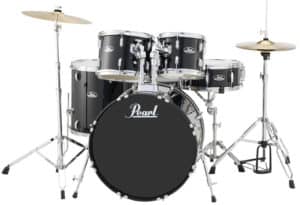 Luckily, we’re here to give you the straight facts and recommendations you need to make an educated decision. Our goal with this article is not to sway you to a particular brand or configuration, but to give you the information in an easily digestible manner.
Luckily, we’re here to give you the straight facts and recommendations you need to make an educated decision. Our goal with this article is not to sway you to a particular brand or configuration, but to give you the information in an easily digestible manner.
We’ll walk you through selecting the perfect starter drumset for anyone just beginning their percussive journey.
Drum Set Components
Before we dive into recommending specific drum sets, brands or configurations, it is important to have a basic understanding of the various components of a drum set. This baseline knowledge will help you better understand what it is you are buying so that you can weigh various factors such as quality vs. value, which are generally factors inversely proportional to each other.
The Big Three: Bass Drum, Snare Drum and Hi-Hat
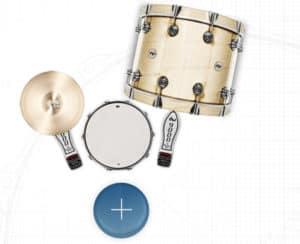 These three primary components are the very foundation of any drum set, no matter how large or small. In fact, some of the most amazing drummers can play some mind boggling things with the big three.
These three primary components are the very foundation of any drum set, no matter how large or small. In fact, some of the most amazing drummers can play some mind boggling things with the big three.
- Bass Drum: Often referred to as the ‘kick drum’, it lays on its side and is played with a foot pedal. It is the bass, or lowest voice of the drum set.
- Snare Drum: Where the bass drum is the lowest drum in the kit, the snare drum is typically the highest pitched drum. The drum itself has a set of tensioned wires on its bottom drum head, producing a very sharp sound.
- Hi-Hat: The hi-hat consists of two cymbals which are mounted on top of each other on a special stand. Operating a foot pedal at the base of the stand opens and closes the space between these two cymbals and can create some very unique effects. The hi-hat is most commonly used to play more intricate notes and to help keep time.
Here is an example of ‘the big three’ in action:
https://www.youtube.com/watch?v=9alvzFMAs-E
Drum Throne
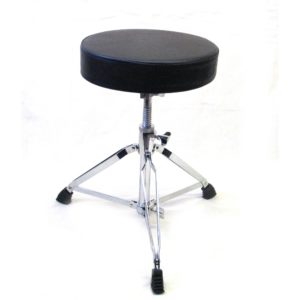 In the video, you might have noticed the drummer sitting on a stool. This is commonly referred to as the drum throne and comes in all sorts of different variations. These days, a lot of starter drum sets actually include a throne but that isn’t always the case, so you’ll want to double check this before making a purchase.
In the video, you might have noticed the drummer sitting on a stool. This is commonly referred to as the drum throne and comes in all sorts of different variations. These days, a lot of starter drum sets actually include a throne but that isn’t always the case, so you’ll want to double check this before making a purchase.
Drum thrones are an important part of the kit that is not to be overlooked, mainly because it is specifically designed for playing drums and it is also height adjustable. This is important in order to maintain the correct posture while playing.
Toms
The drums you see suspended on top and to the side of the bass drum are called toms. Most drum sets typically include at least 2-3 toms. These instruments make up the middle voice of the drum set and are mainly used for drum fills between phrases of a piece of music. While there are many different synonyms for these drums, you’ll generally see two types of toms associated with drum sets:
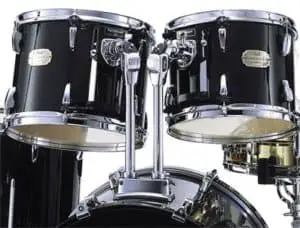 Rack Toms( or High Toms): These are the drums mounted directly above the bass drum. In a standard drum kit for right-handed drummers, they are usually mounted in order of descending pitches going from left to right. Typical diameter sizes for these drums can range from 10″ down to 14″, though smaller and larger sizes definitely exist.
Rack Toms( or High Toms): These are the drums mounted directly above the bass drum. In a standard drum kit for right-handed drummers, they are usually mounted in order of descending pitches going from left to right. Typical diameter sizes for these drums can range from 10″ down to 14″, though smaller and larger sizes definitely exist.
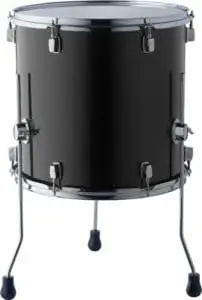 Floor Toms are named so because they have three legs attached to the shell which allows them to stand independently on the floor. Most configurations only include one floor tom placed by the right knee of the drummer, although sets with two floor toms is not that uncommon.
Floor Toms are named so because they have three legs attached to the shell which allows them to stand independently on the floor. Most configurations only include one floor tom placed by the right knee of the drummer, although sets with two floor toms is not that uncommon.
Cymbals
Cymbals are pieces of alloy metal that are lathed and hammered into convex shapes that are generally pretty thin. They provide the brilliant, high-pitched, dramatic voice for the drummer. Most cymbals consist of two major parts:
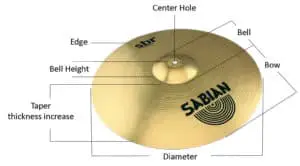 The Bell: This is the very top part of the cymbal in the center that is usually raised up a few inches.
The Bell: This is the very top part of the cymbal in the center that is usually raised up a few inches.- The Bow: The gently sloping portion of the cymbal towards the outer edge of the instrument.
We’ve already talked about one type of cymbal most commonly used, the hi-hat. There are several other types of cymbals also used on a drum set, some more frequently than others. To start with, let’s talk about the basics that any starter drum set should have:
- Crash Cymbal: This is the accent cymbal, used to accompany big moments in music such as the end of a phrase, the end of a drum fill or the climax of a musical buildup. These cymbals are typically 14″ to 16″ in diameter.
- Ride Cymbal: This cymbal is often used to complement the hi-hat by providing an alternative means to keeping steady time along with the bass and snare drums. 16″, 18″ and 20″ are the typical sizes for these cymbals.
In addition to these aforementioned basics, you’ll also encounter the following types of cymbals that allow the drummer to create additional colors and unique effects with their playing.
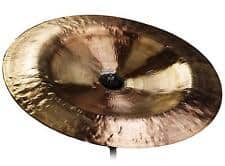 China Cymbal: This oddly shaped cymbal produces what drummers often refer to as a ‘trashy’ sound. It can be used for accents as well as a ride effect as well.
China Cymbal: This oddly shaped cymbal produces what drummers often refer to as a ‘trashy’ sound. It can be used for accents as well as a ride effect as well.
- Splash Cymbal: Splash cymbals are usually the smallest instruments on the drum kit, with diameters ranging from 4″ to 10″. Because it is so much smaller, it produces a very high pitched sound, making it perfect for matching small accents in the music.
4-Piece vs. 5-Piece
Four and five piece drum configurations are definitely the most common, but what does that REALLY mean? Don’t let the hi-hat or cymbals distract you here, because this number refers strictly to the number of drums present in the kit. In other words, a four-piece drum set includes one bass drum, one snare drum, and two toms (typically one rack and one floor). The five-piece kit usually adds another rack tom to the four-piece configuration.
As to which one is better? It honestly doesn’t matter and is 100% up to personal preference. That said, the one major benefit to acquiring a four piece drum kit as a budget conscious beginner is that they are typically a little bit less expensive to get into.
Acoustic Drums vs. Electric Drum Sets
The debate on acoustic vs. electric could probably be the subject of another entire blog, but I thought it would be important to highlight some details that are especially relevant to beginners who are in the market for a kit.
First and foremost, the number one reason electric drum kits even get mentioned is the noise factor. One of the most wonderful things about these sets is that they are marvelously quiet and allow for a much less stress filled environment at home while little Jimmy is practicing.
In my opinion though, most cost-effective electric drum sets come with rubber pads that, in my experience as a teacher, can lead to new drummers building some pretty bad habits in terms of technique. As such, I generally would recommend that beginners start with acoustic drums unless:
- Higher-priced sets can be purchased that more accurately simulate acoustic drums
- Complete silence is necessary – in another article, we will discuss how mesh heads and special cymbals can make even acoustic drum sets relatively quiet instruments.
Value
As the father of a budding musician myself, I know that every dollar counts and therefor completely sympathize with parents wanting to go with the cheapest possible solution to buy an instrument for their kids. There are some pretty cheap drums out there. The problem is that they are usually a complete waste of money because of two main factors:
- Quality – The old adage, “You get what you pay for” is mostly sound when it comes to buying drums. Buying a $100 drum set that falls apart as you take it out of the box may not be the most sensible buy. More on quality in the next section.
- Watch out for items not included – There are many ‘starter drum sets’ on the market, but not all of them come with everything you need to get started. The items you’ll want to watch out for are cymbals, a drum throne, bass drum pedal & mounting hardware. There are starter kits out there that even include sticks and a stick bag…but that is definitely the exception, not the rule.
The moral of the story here is, spend a bit more money if you want something that is going to last a little while and make sure that whatever you do buy won’t lead to any additional major purchases as soon as you open the box at home and realize a major component wasn’t included.
Build Quality
Just like with any major purchase, quality is a factor worth considering carefully. Even if you are the most budget conscious drum shopper, settling for something ultra cheap could potentially mean more money down the road for replacement gear.
That said, let’s look at some specific factors you’ll want to take stock of as you make your purchase decision:
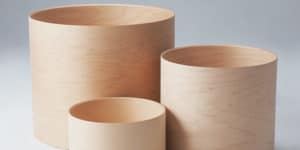 Drum Shells: Producing drum shells is a science that involves laminating multiple layers (or plies) of wood together and using steam to bend them into a perfectly circular tube. These tubes are later cut down into individual drums and are given ‘bearing edges’, which minimize the amount of contact between the drum shell and the drum head. All of that said, the key for beginner drum sets is to look for a kit that actually uses this process with real wood.
Drum Shells: Producing drum shells is a science that involves laminating multiple layers (or plies) of wood together and using steam to bend them into a perfectly circular tube. These tubes are later cut down into individual drums and are given ‘bearing edges’, which minimize the amount of contact between the drum shell and the drum head. All of that said, the key for beginner drum sets is to look for a kit that actually uses this process with real wood.
- A lot of inexpensive kits use particle board formed into the shape of a shell.
- Long story short, you’ll want to look out for 5 to 9 ply wood shells, made of mahogany, birch, maple or any combination of real wood.
 Double Braced vs. Single Braced Hardware: The key word to look out for here is double braced hardware. It’s actually harder these days to find the older style flimsy hardware that was once the norm, so this should be a relatively easy one to check off. Hardware that is double braced is much sturdier and can stand up to more punishment over time.
Double Braced vs. Single Braced Hardware: The key word to look out for here is double braced hardware. It’s actually harder these days to find the older style flimsy hardware that was once the norm, so this should be a relatively easy one to check off. Hardware that is double braced is much sturdier and can stand up to more punishment over time.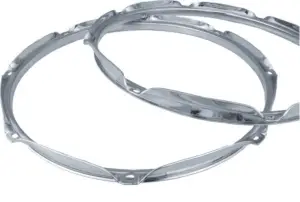 Hoops: Triple Flanged Hoops are the circular metal rings which press the drum head down over the shell, providing the necessary tension to tune the drum. They are called this because there are literally three bends in the metal. These hoops generally come in two weights (1.6mm or 2.3mm), the latter of which is a bit sturdier and more resistant to warping. One way manufacturers cut down on cost is by using the lighter 1.6mm hoops on their drums. This is by no means a show stopper and definitely something that can be upgraded later if you need to.
Hoops: Triple Flanged Hoops are the circular metal rings which press the drum head down over the shell, providing the necessary tension to tune the drum. They are called this because there are literally three bends in the metal. These hoops generally come in two weights (1.6mm or 2.3mm), the latter of which is a bit sturdier and more resistant to warping. One way manufacturers cut down on cost is by using the lighter 1.6mm hoops on their drums. This is by no means a show stopper and definitely something that can be upgraded later if you need to.- Brand/Manufacturer: Ultimately this doesn’t really matter too much as most brands and even smaller drum builders have a starter kit available. That said, by sticking to some of the major brands available in the marketplace (listed below), you’ll likely be able to get more value for the money, as these companies typically have much better purchasing power for parts, helping drive down the overall cost of the drum set.
The bottom line:
My recommendation for beginners would be to really pay attention to a product’s specifications and look for a beginner drum set with the most bang for the buck. I’ll list some specific recommendations that meet this criteria a bit later in this article.
Age Specific Drum Sets
It may seem ridiculous to put a massive adult-sized drum set in front of a 6-year-old, but that is precisely what should be done more times than not. That said, there are two general categories of drum sets:
- Junior: A lot of manufacturers product scaled down version of their larger kits, specifically designed for kids. There is no set rule as to the age ranges these drum sets are designed for, however I would say this setup would be ideal for kids ages 3 to 8. There will come a time where they will look absolutely ridiculous behind a small drum set like this, at which point you’ll probably want to acquire a full-sized kit. (Think Andre the Giant behind a normal drum set)
- Full Size: Full size drum sets come in all sorts of sizes and configurations. Depending on your situation, it may be more economical to go ahead and purchase a full size drum set instead of first looking at a junior option. Smaller ‘jazz’ or ‘fusion’ drum sets would work nicely for kids who are right on the edge, but need a kit they can grow into.
Brand
While the brand of your new drums doesn’t have a huge impact on learning to play the drums, there are factors that could be beneficial when going with a reputable brand.
The brands we would advise you to stick with are as follows (in no particular order):
- Pearl
- Tama
- Yamaha
- Gretsch
- PDP (Pacific Drums & Percussion)
- Ludwig
Specific Drum Set Recommendations
Here is a short list of drum kits I would recommend based on the criteria I’ve laid out for you in this article.
Pearl Roadshow
A solid starter kit from a reputable manufacturer. It’s a great value because it includes everything including all hardware, a throne and even cymbals. If you’d like more detailed info about it, be sure to read my review for my thoughts on this kit.
PDP Mainstage
PDP is DW’s budget brand and offers an excellent value kit with its Mainstage series as it also includes Paiste cymbals and hardware. In other words, there’s nothing more you’ll need to buy!
Summary
To summarize this article, there are certain factors to pay attention to when buying a drum kit for beginners, with build quality and value (bang for the buck) being probably the most important decision criteria.
[/et_pb_text][/et_pb_column][/et_pb_row][/et_pb_section]
